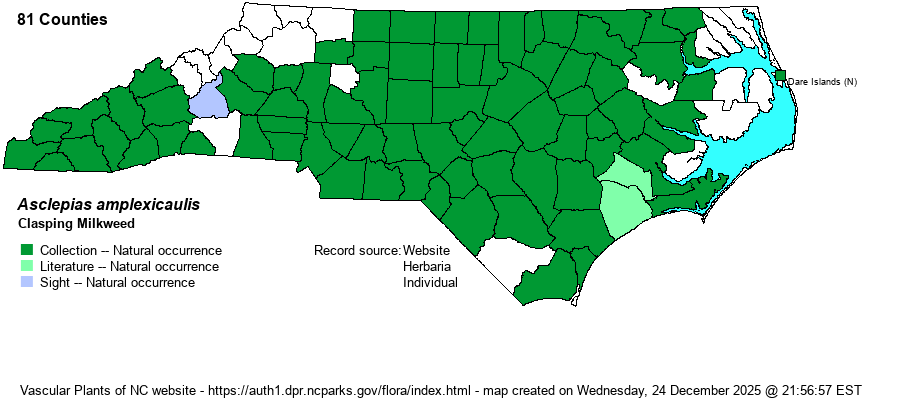| Author | J.E. Smith | |
| Distribution | Throughout the Piedmont and nearly all of the Coastal Plain, except scarce to absent near the northeastern coastal areas. Throughout the southern half of the Mountains but perhaps absent in the northern portions.
This is a widespread Eastern species, ranging from New England west to MN, and then south to central FL and eastern TX. | |
| Abundance | Fairly common to common in the Piedmont and most of the Coastal Plain, but very rare in the far northeastern Coastal Plain. Uncommon to frequent in the southern and central Mountains, but perhaps absent farther north. One of the more widespread milkweed species in the state, but a given population usually consists of 3 or fewer plants. | |
| Habitat | This is a milkweed of dry soil in partial shade/sun. It favors upland woodland openings and borders, pine/scrub oak sandhills, various barrens and glades, and other semi-shaded and dry soils. |
| Phenology | Blooms from May to July, and fruits from June to August. Flowers smell of cloves. | |
| Identification | This is an easy species to identify, thankfully familiar to most people. It has an erect stem growing to about 2-2.5 feet tall, with 4-6 pairs of opposite leaves scattered along the smooth stem. These leaves are rather large and broadly elliptic to oblong, with a rounded tip and clasping bases, where the base meets the base of the other leaf in the pair and clasps the stem. The leaves are 4 inches long and about 2 inches wide, entire, but have distinctive very wavy margins, so that the leaf is clearly not in a flat plane. This species has only one flower cluster; the umbel grows at the top of the stem, with a rounded cluster (about 3 inches across) of a few dozen dull purple to greenish-purple flowers, fairly colorful but not as strikingly beautiful as in several other species. All milkweeds have large capsules that are up to 4 inches long, with "fluffy" or "feathery" seeds, but milkweeds are identified by their leaves and flower color, and not by the fruit shape or structure. This species seldom grows in colonies, and thus you likely will just encounter one to several plants scattered here and there. Still, it is not as scarce or local as some milkweeds in the state, and thus encounters can be numerous during the year. | |
| Taxonomic Comments | None
| |
| Other Common Name(s) | Wavyleaf Milkweed, Blunt-leaved Milkweed, Curly Milkweed, Sand Milkweed | |
| State Rank | S5 | |
| Global Rank | G5 | |
| State Status | | |
| US Status | | |
| USACE-agcp | | |
| USACE-emp | | |

